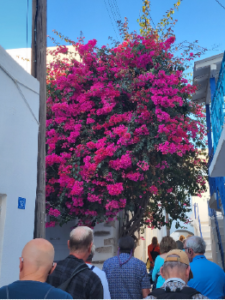By Terry Twigg
(November 2, 2025) — I’ve been back from Greece for more than two weeks already, but I’m still not quite readjusted. To the weather, first: when I left, Connecticut was still clinging to summer, and two weeks of wearing linen and tee shirts perpetuated that illusion, but a sneaky early frost changed all that, and we’ve already had a few nights chilly enough for fires. My time away coincided with the most glorious weeks of the New England gardener’s year, as the dahlias came into their own, marigolds literally fell over themselves trying to cram in as many flowers as possible before the season ended, and asters’ starlike flowers popped up everywhere. I missed all of that, and came home to bedraggled blossoms and crumpled leaves. I’d planned to set myself up with a winter’s worth of pesto, but all the basil plants, so bright green and healthy when I left, had turned black when the temperature dropped.

And I’ve had to readjust to the plants, too. Olive trees have been replaced by apples, oleander by late chrysanthemums, and hot pink bougainvillea (photo above, in Paros, Greece) by the bright orangey-red leaves of sugar maples. Different, but well loved. One unfortunate similarity: it turns out that Tree of Heaven, ailanthus altissima, is as much of a hated invasive there as it is here.
Even geology required my brain to retool. The island of Santorini, formerly Thera, was the site of one of the largest volcanic events in human history. The eruption of the volcano around 1600 B.C. blasted a formerly round island into a crescent shape, all that’s left after the center of the island sank into the sea. It devastated the eastern Mediterranean with tsunamis and thick deposits of rock and ash, and destroyed the Minoan civilization on Crete. Here at home, the only volcanoes I see are mulch volcanoes. They won’t destroy our civilization, but they’ll definitely kill your trees.
More challenging is a different perception of time. It’s not just that the Greeks live their ordinary modern lives surrounded by four-thousand-year-old ruins, reminders of the ancient past. The plants themselves conspire to demand a slower pace. Gardening by its very nature demands patience, but every garden-related publication or website will showcase at least one article per year on the fastest way to get the garden of your dreams: which are the fastest growing trees, the soonest-blooming annuals, the shortcuts to clearing beds and creating an instant effect. Buy the bigger tree instead of the sapling; choose the 2-gallon perennials instead of the 6-pack of seedlings. (I call this “checkbook gardening.”)

But in Greece, where every available square foot of arable land, right up to the very edges of the airport runways, is planted with olives, patience is forced upon the grower, because olive trees aren’t mature enough to produce fruit until they’re sixty years old. They’ll make up for it eventually–we saw trees still producing after three thousand years (photo above)– but anyone planting an olive knows it’s not for today or even next year, but for posterity.
By far the most striking difference is in landscapes as a whole. Greece has been intensively agricultural for as far back as anyone can guess. The U.S. was, too, for the first few hundred years of our very short history, but while the Industrial Revolution drastically changed our country, it had far less of a visible impact on Greece, or, at least, the parts I visited. I saw no rows of suburban houses, and no expanses of lawn, with one exception: the high-end resort hotels of Mykonos and Santorini surrounded themselves with grass and palm trees, expensively irrigated and glaringly at odds with their surroundings.
Every other building, from the humblest farmhouse to the most expensive estate, contented itself with a relatively modest paved area, often fenced in, brightened with a scattering of flowering plants in pots. The rest of the yard was crowded with olives, grapes, or pomegranates. No lawn worshipping! And no car worshipping, either: Crete and Athens have some modern highways, though I never saw one wider than two lanes in either direction, but the narrow island roads still follow tracks worn into the rocky soil by foot and donkey centuries ago, detouring around the steepest hills, the rockiest gullies, and groves planted by the ancestors of the current residents.
If you’re used to American roads, straightened out by the simple expedient of blasting your way through inconvenient rock, the meandering lanes and irregularly placed houses on the islands might appear random, but they have a charm lacking in the soulless ranks of houses built along I-95.
My mostly English-style garden includes homely American native plants and a suggestion of a Spanish courtyard. When I reinstall my row of recycled porch columns, made a hundred years ago in the same Doric style as the columns of the Parthenon but blown down in a storm last year, I can add Greek elements to the mix. Where will I go next time, and what ideas will I bring back with me?
Photos by Terry Twigg


Comments are closed.